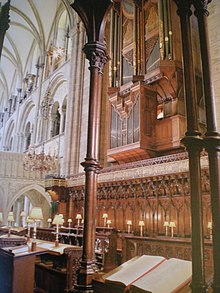Chichester Cathedral
The Chichester Cathedral , officially: The Cathedral Church of The Holy Trinitiy is an Anglican cathedral in the southern English city of Chichester , West Sussex .
history
founding
Chichester Cathedral was built on the foundations of a Roman basilica after the episcopal seat was moved from the nearby village of Selsey in 1075 . The first construction work began around 1076 under Bishop Stigand. Bishop Ralph de Luffa dedicated the cathedral to the Holy Trinity in 1108. In 1187 a fire destroyed the eastern part of the cathedral and the wooden roof structure, which was replaced by a stone vault. The construction of a retro choir in the Early English style and the addition of numerous side chapels in the 13th century made the church one of the most extensive in England.
Richard of Chichester
In 1262, Pope Urban IV canonized Bishop Richard of Chichester , who had died only nine years earlier. His grave in the retro choir was one of the most important pilgrimage sites in England until it was destroyed in 1538 by order of Henry VIII .
expansion
In the 14th century, the cathedral received a crossing tower and a Lady Chapel. In the 15th century, the addition of cloisters to enclose the south transept changed the exterior of the cathedral. A special feature is the free-standing bell tower built in 1436 on the north-west side of the cathedral. Today it rings eight bells and is the only remaining campanile in England.
destruction
The destructive rage of the church attackers during the Reformation period did considerable damage to the cathedral. Memorial plaques were stolen, carvings and sculptures damaged, and the St. Richards shrine and medieval stained glass windows were completely destroyed.
Further damage took the church when in 1642 during the reign of Cromwell , the Parliament troops occupied the city. For the next two centuries, the cathedral was neglected and fell into disrepair.
reconstruction
It was not until the 1840s that restoration work began under Dean George Chandler. However, these suffered a setback when the crossing tower collapsed in 1861. It was able to be rebuilt in 1866 and was given today's tall spire.
The 82 meter high tower is said to be the only spire in England that can be seen from the sea.
Furnishing
The interior contains a wealth of works of art from various eras.
Historical art
In the central nave there are remains of a Roman mosaic floor from the 2nd century. In the south aisle of the choir two Romanesque sandstone reliefs from the early 12th century can be seen: "The awakening of Lazarus" and "Christ on the arrival in Bethany". They are considered to be unique representatives of pre-Gothic sculpture in England.
The choir stalls date from 1330, the choir screen from 1475.
The most outstanding of the many interesting tombs in the cathedral is the 14th century sarcophagus of Richard Fitzalan Earl of Arundel and his wife Eleanor.
Lady Chapel
In the Marienkapelle on the east side, the ceiling painting by Lambert Bernard from 1533 has been preserved. It is the last remaining part of the original ceiling painting of the whole cathedral. Stylized portraits of bishops and paintings of kings and queens from the 16th century by Lambert Bernard adorn the transepts.
Modern art
The cathedral also contains a variety of modern works of art. The Chagall church window from 1976 (depiction of the 150th Psalm) can be seen in the northern choir apse . To the right behind the west entrance is the baptismal font made by John Skelton in 1983 and made of black Cornwall stone and copper. The painting by Hans Feibusch (1952) right next door shows the baptism of Christ. The altarpiece “Noli me tangere” (1962) by Graham Sutherland hangs in the Maria Magdalena Chapel .
The modern tapestry in the choir behind the high altar was designed by John Piper in 1966 and woven in France, the motif is the Holy Trinity. The German-English tapestry by Ursula Benker-Schirmer (1985) in the retro choir shows biblical symbols related to the life and legends of Saint Richard of Chichester. The sculpture of Mary created by John Skelton in 1988 is in the Lady Chapel.
organ
The organ consists of pipe material from several well-known English organ builders. The organ case was built in 1888 by Dr. Arthur Hill designed. The prospect pipes date from 1678. The instrument initially had 35 registers. 1984–1985 the organ was extensively renovated and reorganized.
Main organ
The main organ today has 48 stops on four manuals and a pedal.
|
|
|
|
|
|||||||||||||||||||||||||||||||||||||||||||||||||||||||||||||||||||||||||||||||||||||||||||||||||||||||
- Pair: I / II, III / II, IV / II, I / P, II / P, III / P, IV / P
The Nave Organ , which has 7 stops on a manual and pedal and has its own console, can also be played from the general console.
|
|
|||||||||||||||||
Church music
Leonard Bernstein composed his Chichester Psalms in 1965 for the Southern Cathedrals Festival, which takes place annually alternating between the cathedrals of Salisbury and Winchester .
Unusually for a cathedral, a performance by the rock band Pink Floyd took place here when they played for the funeral of their manager Steve O'Rourke . Bob Geldof , Rolf Harris and The Hollies also performed in the cathedral .
literature
- Harry Batsford, Charles Fry: The Cathedrals of England , 7th Edition, BT Batsford Ltd., London 1948
Individual evidence
- ^ Harry Batsford, Charles Fry: The Cathedrals of England , p. 26
- ↑ More information on the history and disposition of the organ on the website of the organ building company
Web links
Coordinates: 50 ° 50 ′ 10.7 " N , 0 ° 46 ′ 50.9" W.






